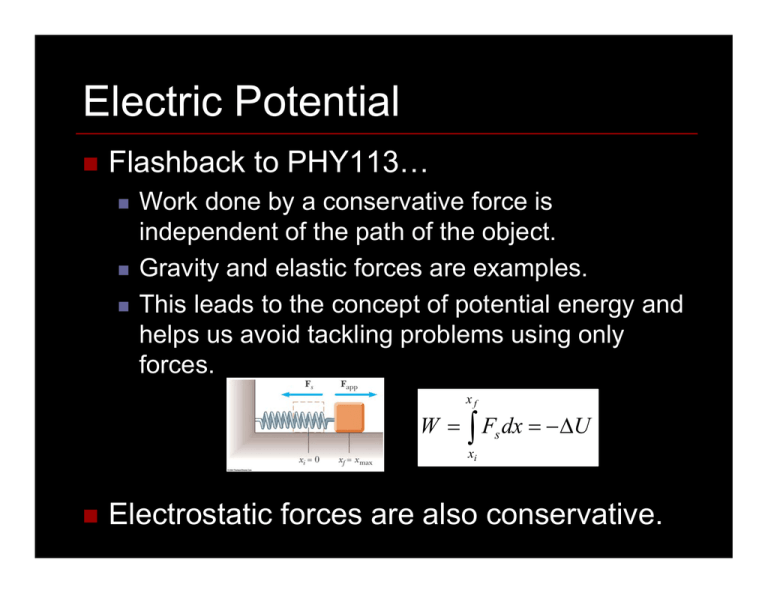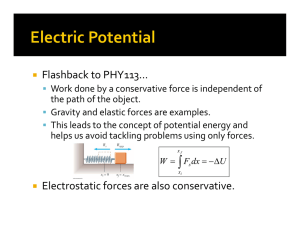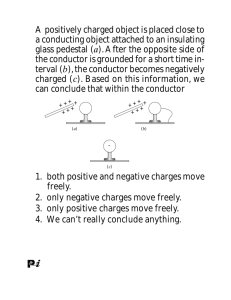Electric Potential Energy
advertisement

Electric Potential Flashback to PHY113… Work done by a conservative force is independent of the path of the object. Gravity and elastic forces are examples. This leads to the concept of potential energy and helps us avoid tackling problems using only forces. xf W = ∫ Fs dx = − ΔU xi Electrostatic forces are also conservative. Electric Potential Energy B v E v v F = q0 E v v ΔU = − ∫ F.d s = −q0 path v v ∫ E.d s path A q0 …but F is a conservative force …so the path we take does not matter v w ΔU = −q0 ∫ E.d s B A Electric Potential Work, ΔU, is dependent on the magnitude of the test charge, q0. We’d like to have a quantity independent of the test charge and only an attribute of the electric field. U V= q0 v v ΔU ΔV = = − ∫ E.d s q0 A Electric Potential (J/C=V) Potential Difference between A and B B P VP = − ∫ E.ds ∞ Electric Potential at P Unit Pit Stop Potential V =J C Energy J = N ⋅m Electric Field N ⎛ V .C ⎞⎛ J ⎞ N C= ⎜ ⎟ =V m ⎟⎜ C ⎝ J ⎠⎝ N .m ⎠ Electron-Volt 1eV = e(1V ) = 1.6 ×10 −19 C (1 J C ) = 1.6 ×10 −19 J ( ) Electric Potential in a Uniform Field B B B A A A ΔV = − ∫ E.ds = − ∫ E cos 0°ds = − E ∫ ds ΔV = − Ed ΔU = −q0 Ed Electric field lines point to decreasing potential. A positive charge will lose potential energy and gain kinetic energy when moving in the direction of the field. Equipotential Surfaces D B s E B B A A ΔV = − ∫ E.ds = −E.∫ ds = −E.s θ C A ΔV = −( E.s) AC − ( E.s)CB ΔU = −q0 (E.s) AC − q0 (E.s) CB ΔV = − Es AC cos 0° − EsCB cos 90° ΔU = −q0 Es AC cos 0° ΔV = − Es cos θ ΔU = −q0 Es cos θ D D A A ΔVAD = − ∫ E.ds = −E.∫ ds = −E.s = −( E.s) AC − ( E.s)CD = − Es cos θ No work is done moving a charged particle perpendicular to a field (along equipotential surfaces) Equipotential Surfaces Uniform Field Point Charge Electric Dipole Electric Potential of a Point Charge B VB − VA = − ∫ E.ds A E.ds = k e q q q ˆ r . d s = k ds cos θ = k e 2 e 2 dr 2 r r r VB − VA = − ∫ Er dr ⎡1 1⎤ dr k q = − ⎥ e ⎢ 2 r r ⎣ B rA ⎦ rA rB VB − VA = −ke q ∫ V A= ∞ = 0 q V = ke r Two Point Charges ⎛ q1 q2 ⎞ VP = ke ⎜⎜ + ⎟⎟ ⎝ r1 r2 ⎠ A System of Point Charges q1q2 U = ke r12 ⎛ q1q2 q2 q3 q3q1 ⎞ ⎟⎟ U = ke ⎜⎜ + + r23 r31 ⎠ ⎝ r12 Concept Question Two test charges are brought separately into the vicinity of a charge +Q. First, test charge +q is brought to a point a distance r from +Q. Then this charge is removed and test charge –q is brought to the same point. The electrostatic potential energy of which test charge is greater: 1. +q 2. –q 3. It is the same for both. Getting From V to E E B V = − ∫ E.ds A E dV Er = − dr dV = −E.ds ∂V In general: E x = − ∂x dV Ex = − dx ∂V Ey = − ∂y ∂V Ez = − ∂z Electric Potential of a Dipole 2ke qa VP = 2 2 x −a 2ke qa V≈ x2 (x >> a) dV 4ke qa Ex = − = dx x3 Between the Charges 2ke qx VP = 2 a − x2 ⎛ a2 + x2 ⎞ dV ⎟ Ex = − = −2ke q⎜ 2 2 ⎟ 2 ⎜ dx ⎝ (a − x ) ⎠ Electric Potential Due to Continuous Charge Distributions Start with an infinitesimal charge, dq. dq dV = ke r Then integrate over the whole distribution dq V = ke ∫ r Electric Potential Due to a Uniformly Charged Ring keQ V= E= x2 + a2 (x keQx 2 +a ) 2 3/ 2 Electric Potential Due to a Finite Line of Charge keQ ⎛⎜ l + l 2 + a 2 ln V= ⎜ l a ⎝ ⎞ ⎟ ⎟ ⎠ Electric Potential Due to a Uniformly Charged Sphere Er = k e Q r2 r r>R kQ Er = e 3 r R r<R r VD − VC = − ∫ Er dr = R keQ ⎛ r2 ⎞ ⎜⎜ 3 − 2 ⎟⎟ VD = 2R ⎝ R ⎠ ( keQ 2 2 R −r 3 2R ) r dr r2 ∞ VB = − ∫ Er dr = − keQ ∫ ∞ VB = ke Q r VC = k e Q R Potential Due to a Charged Conductor Charges always reside at the outer surface of the conductor. The field lines are always perpendicular to surface. Then E.ds=0 on the surface at any point. Which means, VB-VA=0 along the surface. The surface is an equipotential surface. Finally, since E=0 inside the conductor, the potential V is constant and equal to the surface value. Connected Charged Conducting Spheres q1 r1 = q2 r2 E1 r2 = E2 r1 Cavity Within a Conductor B VB − VA = − ∫ E.ds = 0 A We can always find a path where E.ds is non-zero. But, since ΔV=0 for all paths, E must be zero everywhere in the cavity. A cavity without any charges enclosed by a conducting wall is field free. Summary Charges can have different electric potential energy at different points in an electric field. Electric potential is the electric potential energy per unit charge. All points inside a conductor are at the same potential. For Next Class Reading Assignment Chapter 26 – Capacitance and Dielectrics WebAssign: Assignment 3




